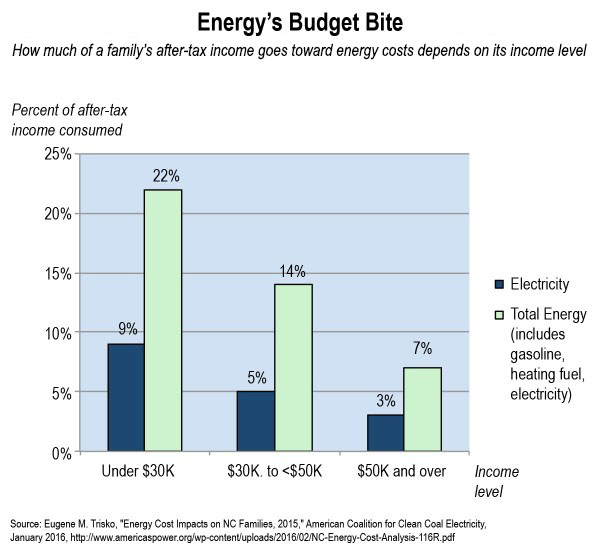 The editorial, by Utah State professor William Shughart and researcher Michael Jensen, reiterate points made here. They argue that the politicized drive for “green energy” is drowning out the much greater problem of energy poverty.
The editorial, by Utah State professor William Shughart and researcher Michael Jensen, reiterate points made here. They argue that the politicized drive for “green energy” is drowning out the much greater problem of energy poverty.
(The chart on the right comes from a recent Locker Room post about energy poverty in North Carolina.)
“Modern progressives,” they write, “who have long fancied themselves as champions of the poor” — and I’d add and see themselves as valiant opponents of government favors serving corporate greed, except when it’s corporate greed for massive renewable energy subsidies —
now see energy policy only through the lens of climate change. Their call to reduce greenhouse gas emissions, at any cost, drives public policy. Consequently, the sources of our most reliable and affordable electricity, existing coal power plants, are being shut down across the country as overzealous federal and state regulatory mandates force utilities to use less reliable, and more expensive sources such as wind and solar power.
For those on fixed incomes, increasing energy prices mean that the gap between what they can afford to pay and what they are paying for electricity is widening. If we continue to push aside cheap coal-generated electricity for more expensive alternatives, many more of the nation’s poor will fall into that gap as they struggle to keep their lights on and their refrigerators running.
To be considered affordable, utility bills should be no more than 6 percent of one’s income. But according to new research, energy costs now represent 20 percent or more of income for many of the poorest Americans. That affordability gap of 14 percentage points translates into an extra $40 billion per year.
For a recent discussion of these same issues here, read this post: “Even more reasons why renewable energy mandates make electricity cost much more than it should.” That’s where you’ll encounter this:
- Electricity from new solar is nearly 5 times more expensive than from existing nuclear and over 3.5 times more expensive than from existing coal.
- Electricity from new wind is over 3.5 times more expensive than from existing nuclear and over 2.5 times more expensive than from existing coal.
For more information on those expenses, the graph at the top of this post, and the following graph, read the entry.



